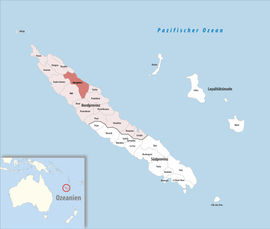Hienghène
Commune in New Caledonia, France From Wikipedia, the free encyclopedia
Commune in New Caledonia, France From Wikipedia, the free encyclopedia
Hienghène (French pronunciation: [jɛ̃ɡɛn] or [jəŋ.ɡɛːn];[3][4] Fwâi: Hyehen)[5] is a commune in the North Province of New Caledonia, an overseas territory of France in the Pacific Ocean. It is located on a bay called Hienghène Bay, known for its eroded limestone islets.[6]
This article relies largely or entirely on a single source. (March 2017) |
Hienghène | |
|---|---|
 "La Poule" (the hen) cliff in Hienghène | |
 Location of the commune (in red) within New Caledonia | |
| Coordinates: 20°41′39″S 164°55′20″E | |
| Country | France |
| Sui generis collectivity | New Caledonia |
| Province | North Province |
| Government | |
| • Mayor (2020–2026) | Bernard Ouillatte[1] |
| Area 1 | 1,068.8 km2 (412.7 sq mi) |
| Population (2019 census)[2] | 2,454 |
| • Density | 2.3/km2 (5.9/sq mi) |
| Ethnic distribution | |
| • 2019 census | Kanaks 94.17% Europeans 2.36% Wallisians and Futunans 0.12% Mixed 2.61% Other 0.73% |
| Time zone | UTC+11:00 |
| INSEE/Postal code | 98807 /98815 |
| Elevation | 0–1,628 m (0–5,341 ft) (avg. 20 m or 66 ft) |
| 1 New Caledonia Land Register (DITTT) data, which exclude lakes and ponds larger than 1 km² (0.386 sq mi or 247 acres) as well as the estuaries of rivers. | |
The islets are remnants of a limestone and silica formation that once covered the whole of the bay, some 40 million years ago.[6] Erosion from wind and water carved away the softer limestone, leaving the harder silica behind in eye-catching formations. Several of these formations have been given fanciful names, such as the Sphinx, the Towers of Notre Dame, and the Hen (pictured).[6]
Seamless Wikipedia browsing. On steroids.
Every time you click a link to Wikipedia, Wiktionary or Wikiquote in your browser's search results, it will show the modern Wikiwand interface.
Wikiwand extension is a five stars, simple, with minimum permission required to keep your browsing private, safe and transparent.